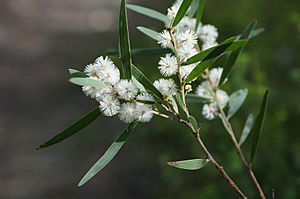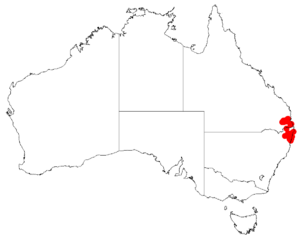Acacia baeuerlenii facts for kids
Quick facts for kids Acacia baeuerlenii |
|
|---|---|
 |
|
| Acacia baeuerlenii flowering in D'Aguilar National Park. | |
| Scientific classification | |
| Genus: |
Acacia
|
| Species: |
baeuerlenii
|
 |
|
| Acacia baeuerlenii occurrence data from Australasian Virtual Herbarium | |
Acacia baeuerlenii is a special kind of shrub, also known as a wattle, that belongs to the Acacia family. It's found only in a small part of eastern Australia. This plant is a bit unique because it has flat leaf-like structures called phyllodes instead of true leaves.
Contents
What Does Acacia baeuerlenii Look Like?
This wattle is a slender shrub. It usually grows to be about 1 to 4 meters (3 to 13 feet) tall. Its branches are angled, ribbed, and have tiny hairs.
Its Unique Leaves
Like many Acacia species, Acacia baeuerlenii doesn't have regular leaves. Instead, it has structures called phyllodes. These phyllodes are flat and look like leaves. They stay green all year round. They are usually narrow and oval-shaped. They can be straight or slightly curved. These phyllodes are smooth and measure about 6.5 to 15 centimeters (2.5 to 6 inches) long. They are also about 4.5 to 13 millimeters (0.17 to 0.5 inches) wide. Each phyllode has several main veins that are spaced far apart.
Flowers and Seed Pods
This wattle blooms between June and August. It produces small, round flowerheads. These flowerheads are about 6 to 11 millimeters (0.2 to 0.4 inches) across. Each one contains 30 to 40 white to cream-colored flowers. These flowers grow in groups of one to three along a short stem.
After the flowers bloom, the plant grows seed pods. These pods are hairy and feel a bit like leather. They are usually straight, but sometimes they can be twisted. The pods are about 6 to 10 centimeters (2.3 to 4 inches) long and 6 to 8 millimeters (0.2 to 0.3 inches) wide. Inside, the seeds are arranged lengthwise. The seeds are a dull dark brown color. They are broadly oval-shaped and about 5 to 5.5 millimeters (0.2 inches) long. Each seed has a thick, fleshy part called an aril.
How Was Acacia baeuerlenii Named?
This plant was first officially described in 1896. Two botanists, Joseph Maiden and Richard Thomas Baker, gave it its scientific name. They wrote about it in a paper called Descriptions of some new species of plants from New South Wales.
Name Changes Over Time
Later, in 1987, another botanist named Leslie Pedley reclassified it. He moved it to a different group called Racosperma baeuerlenii. But in 2001, it was moved back to the Acacia group. So, its official name became Acacia baeuerlenii again.
The second part of its name, baeuerlenii, honors William (Wilhelm) Baeuerlen. He was the person who first collected a sample of this plant for scientific study. This first sample is called the type specimen. Acacia baeuerlenii looks similar to two other wattle species: Acacia tessellata and Acacia venulosa.
Where Does Acacia baeuerlenii Grow?
You can find Acacia baeuerlenii in eastern Australia. Its range stretches from southern Queensland down to northeastern New South Wales.
Specific Locations
In New South Wales, it grows around Maclean, north of Red Rock, and in the Gibraltar Range. Further north, in Queensland, it can be found around Helidon.
Its Habitat
This wattle often grows in sandy soils. It is usually found in dry sclerophyll forests. These are forests where the plants have tough, leathery leaves to help them survive in dry conditions.

